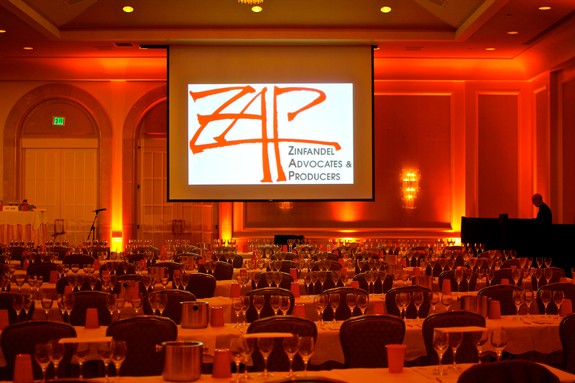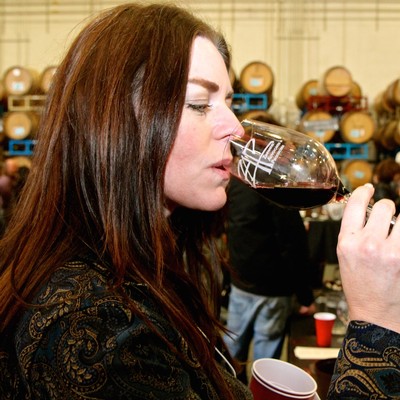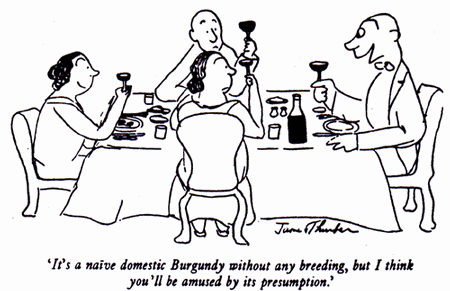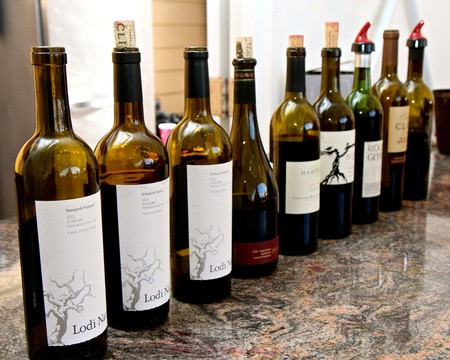Is there such a thing as "Zinfandel Grand Crus" in California?

Room set for ZAP's annual Flights!
tasting
Is there such a thing as “Grand
Crus” rankings of California wines? No, there
isn’t, and for good reason: the California wine industry is
continuously discovering “new” vineyards of undeniably
wonderful quality and interest. We’re not like places in France,
where they carry children around in baskets and vignerons
have had hundreds of years to figure out where the best wines are coming
from.
In a recent blogpost on
Tim Atkin MW’s timatkin.com, Ron Washam made some devastating
comments on one attempt to do so; citing James Laube, who
“wrote California’s
Great Cabernets, a book published by ‘Wine
Spectator Press’ in 1989.” Quoth Washam,
You read that right —
“Wine Spectator Press.” Why does that bring the Special
Olympics of Publishing to mind? In California’s Great
Cabernets, Laube, in his adolescence as a wine critic, took it upon
himself to classify California Cabernet producers into Five Growths —
think Bordeaux’s 1855 classification... The book is a study in
hubris, as well as cheap paper.
The point is that as soon as you make a list of the
top 50 or 60 vineyards where the best Cabernet
Sauvignons are coming from, another 50 or 60 vineyards pop up that
seem to be just as good or better. It’s more like the book, Millions
of Cats – an exercise not so much in hubris as
futility. The California wine industry is growing too darned fast to make even
tentative choices.

Lodi Zinfandel lover at ZAP
And so why, you may ask, is Zinfandel Advocates &
Producers (a.k.a. ZAP) putting on a Zinfandel
tasting of bottlings that, in their words, “sets the stage to push
the conversation about California's own Great Growths”
representing what might be considered the top of the top of our old vine
Zinfandel plantings? This tasting takes place on February 26, 2016 in San
Francisco, as part of the “Flights!
Forum of Flavors” segment of ZAP’s yearly,
three-day-long Zinfandel
Experience.
On their Web site, ZAP goes on to say:
The Bordeaux
Wine Official Classification of 1855 ranked France's best
wines according to a château's reputation and trading price
and is still in use today. Ultimately 61 out of 5000 wine estates were given
the highest ranking and are sometimes referred to as Great Growths or Grand
Crus Classés... Is there a congruence between old vine
vineyards and European great growths?
The simplest answer to ZAP’s question,
even before this tasting takes place, is: No. It is an
exercise in futility, although we shan't say hubris (we
love ZAP, and all great Zinfandels).
Oh, it may be an amusing activity, but there are reasons why it can't
be much more than that:
First: old vine vineyards are not necessarily the
“grandest” sources of Zinfandel. Two of the highest rated
Zinfandels in recent blind tasting competitions, for instance, have come from
vines less than 10 years old (namely, Sam J. Sebastiani’s La Chertosa from
Shake Ridge Ranch in Amador
County, and the Mikami Vineyards
Zinfandel from Lodi). Sure, no one goes around breathlessy proclaiming
“Young Vine” Zinfandel; but doggone it, Zinfandel from
young vines can be good, especially from fantastic sites cultivated by
top-notch growers and finished by crafty winemakers.

One
of James Thurber's most famous cartoons (The Thurber Carnival,
1945)
Secondly: neither critics nor consumers can ever
agree on a criteria as to what constitutes the "best
Zinfandels." The ZAP organizers, for instance, plan to present
Zinfandels from seven vineyards to start their conversation about a possible
“Grand Crus.” Five of those vineyards are located in Sonoma
County and two of them from Napa
Valley; and they all produce the deeply colored, densely
textured, opulently fruited style of Zinfandel that many Zinfandel aficionados
have come to love.
Ah, but what of the far less opulent, lower
alcohol, decidedly more acid-driven styles of Zinfandels grown in, say, Mendocino
Ridge? Or the more moderately structured yet suave, brightly balanced
styles of Zinfandel coming out Sierra
Foothills regions like Amador County, El
Dorado and Calaveras?
In both Paso
Robles and Contra
Costa County they grow full alcohol Zinfandels that often combine
opulence of ripe fruit with almost improbable acid balance. Here in Lodi,
we have recently come to appreciate a more delicate, perfumed, feminine (if you
will) and often earthier style of Zinfandel.
Hey, don't ask us. It has been critics like
Alder Yarrow, who in his widely followed Vinography
blog last year (re The
Lodi Zinfandel Revolution Continues) said that wines like
the Lodi
Native project Zinfandels "not only significantly redeemed my
dissatisfaction with Lodi Zinfandel, it also inspired my faith in the future of
California wine," while talking about the "incredible
diversity and complexity" of Zinfandels from Lodi's better
growths. They like us, they really do - sometimes more than others.

Lodi Native Zinfandels poured at 2015
ZAP
Point being: not everyone believes that the best
Zinfandels are made in the big, black, thick and jammy fruited styles typical
of much of Sonoma County and Napa Valley. Some critics actually hate that;
preferring kinder, gentler, or more restrained, less obviously fruity styles.
So by what standards do we devise a Bordeaux style classification of
Zinfandels, sub-dividing “Grand Crus” growths into, say,
five levels of “grandness?”
We don’t. Not so long as there is
disagreement about such fundamental issues as: Is bigger better? Are the best
Zinfandels the ones with lean and edgy acid balance, or the ones that bounce
like a Sally Rand balloon? Do we give extra credit for earthy, non-fruit
complexities, or do we measure by sheer amount of classic
"jammy" fruitiness. Do we like Zinfandels so rich and dense
with tannin they can absorb tons of pungent, sweet oak, or Zinfandels so
delicate that the barest whiffs of wood will bruise it? Are not floral or more
subtle berry fragrances better?
Then again, that’s the great thing about
ZAP’s yearly Zinfandel Experience.
There's no better place to be for a Zinfandel lover, which is why
Lodi's finest will be there. if you have the stamina or
wherewithal to sip and spit rather than swill everything in sight, you can
experience well over 100 different Zinfandels in myriad styles from
California’s fantastic multiplicity of regions – and then
decide for yourself what is best, maybe even
“Grand.”
Without any pesky list-makers telling you
what's what!

Unsung hero: 115-year-old vine in Lodi's
Marian's Vineyard





Comments